![]()
![]()
![]()
Use LEFT and RIGHT arrow keys to navigate between flashcards;
Use UP and DOWN arrow keys to flip the card;
H to show hint;
A reads text to speech;
12 Cards in this Set
- Front
- Back
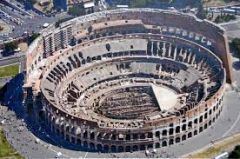
|
Colosseum impreial 72-80 CE travertine, brick, tufa, and concrete iron clamps vespasian (titus) colossal of nero 50,000 people 80 arched passages exterior- velarium capitals are all different |
|
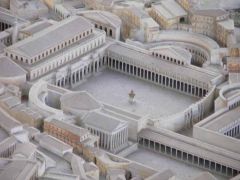
|
Trajans forum architect: 106-112 CE Rome would find libraries, marketplace, law court increasingly emperors compete in creating best for forums marble from all over the empire built into the hill (because the romans "controlled" nature) note the height of Trajans column Roman artists were largely unknown (servants of state) while architect had more prestige |
|
|
j |
Apollodorus of Damascus Basilica of ulpia 112 CE Trajan forum rome brick, concrete, marble law court double colonade, aisle, derisory, timber roof, post and lintel, law courts and meetings apses aisles and nave the term "basilica" is Greek for royal hall and will have 3 reference points in this class 1. Roman public building with legal and political functions 2. a christian church based on the plan of a roman basilica 3. a lage and significant catholic church |
|

|
Column of Trajan 113 CE part of Trajans forum and market marble over 100 ft spiral bas relief, frieze 625 ft narrative 29 drums 2662 figures view from top painted dacian campaigns surrounded by libraries low relief |
|

|
The pantheon 118-125 CE rome patron" Hadrian concrete and marble dedicated to "all the gods" but especially to jupiter and mars and mercury and saturn and venus interior represented orb of earth and vault of heaven exterior is dedication to previous emperor exterior has 2 pediments, deep porch, stairs and platform gone, 40 ft corinthian columns 1 piece niches, corinthian columns, coffers squares and circles, colored marble, radial plan/circular plan/ central plan different mixtures of concrete, wooden scaffolding/frame, base walls 20 ft thick, 6 ft at oculus, barrel vaults hidden in walls, distribute weight of dome, brick and cornet exterior, marble and concrete exterior oculus only source of light, eye of jupiter hemisphere: 142 ft in diameter, height from floor to dome also 142 ft |
|
|
germanic tribes ineffective emperors barracks emperors division of empire christianity crisis of 3rd art becomes a bit from abstract focus on symbolisms and messages rather than likeness |
Late empire 193-337 CE |
|
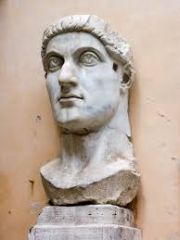
|
Head of constantine 325 CE marble stylized |
|

|
Ludovisi Battle Sarcophagus 250 CE Marble Barbarian vs Roman no sense of space, very crowded composition super high relief goth are more deeply carved attention to interaction, detailed but not individuality goths are harrier Lid of ludovski (barbarian surrender, hostages?) theme relief of the human sarcophogus in highest relief chaos the x signifies that he is a high rank in mystery cult |
|
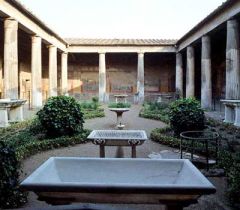
|
House of Vetti Vetti brothers were freed slaves Pompeii, ITaly imperial Rome 1st c CE house (comus) entered from the street via narrow doorway, surrounded by bedrooms (cubical) office of the head of household (paterfamilias) know as the tabling, public part to private private focuses on an open, colonnaded courtyard (peristyle) and small garden (hortus) long axial opens the house up true fresco, buon fresco, wet fresco, smooth plaster surfaces, pigment suspended in a water based solution of lime might also use secco fresco, over it, sealed pigment with wax and oil |
|
|
k |
4 distinct and sometimes contemporary painting styles first style, masonry style, imitate costly marble using painted stucco second style: illusionism, attempt to dissolve the walls and replace them with an allusion of 3D objects third style- ornate style, linear, often monochromatic, dramatic 4th style a mix of others, gallery like |
|

|
Fresco of priapus located in vestibule: entrance included money boxed |
|
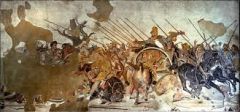
|
Alexander Mosiac 300BCE, 100 BCE roman copy from pompeii private home house of faun |

